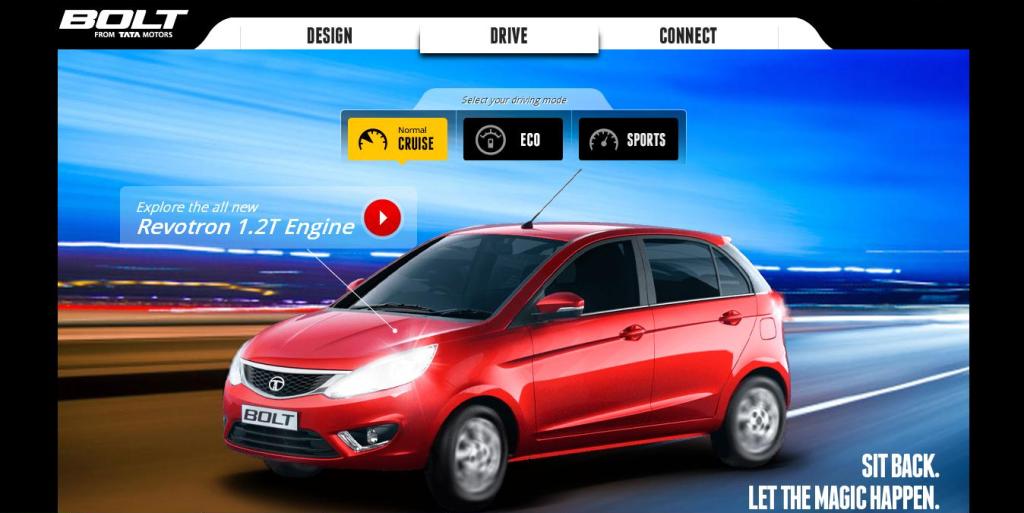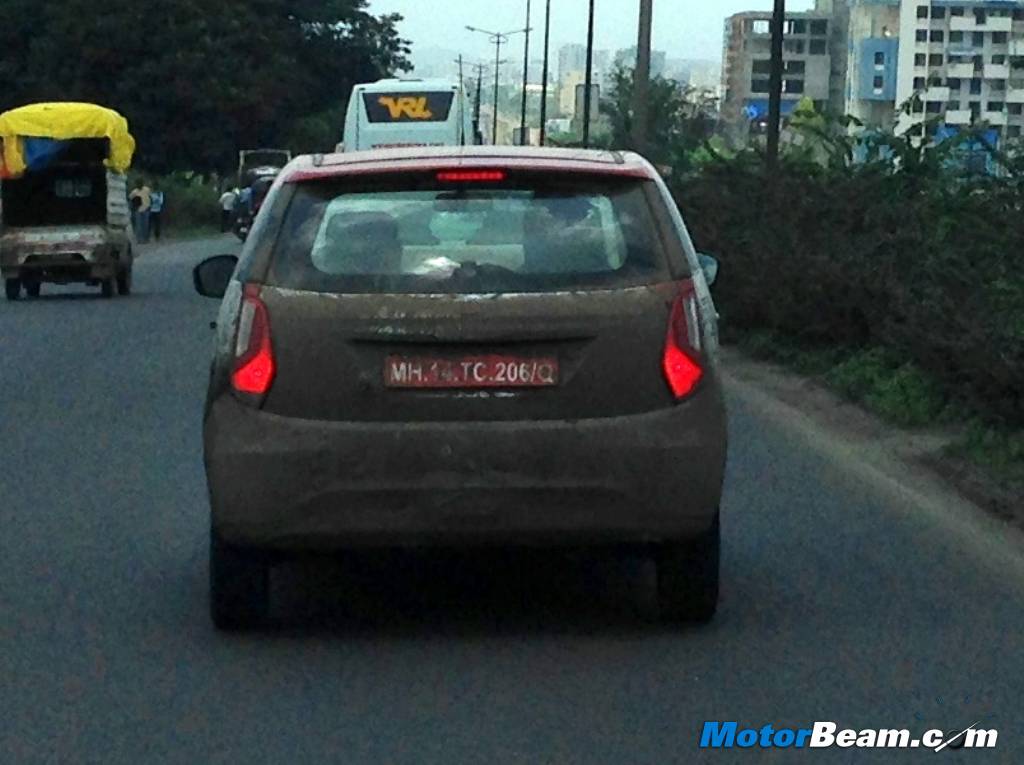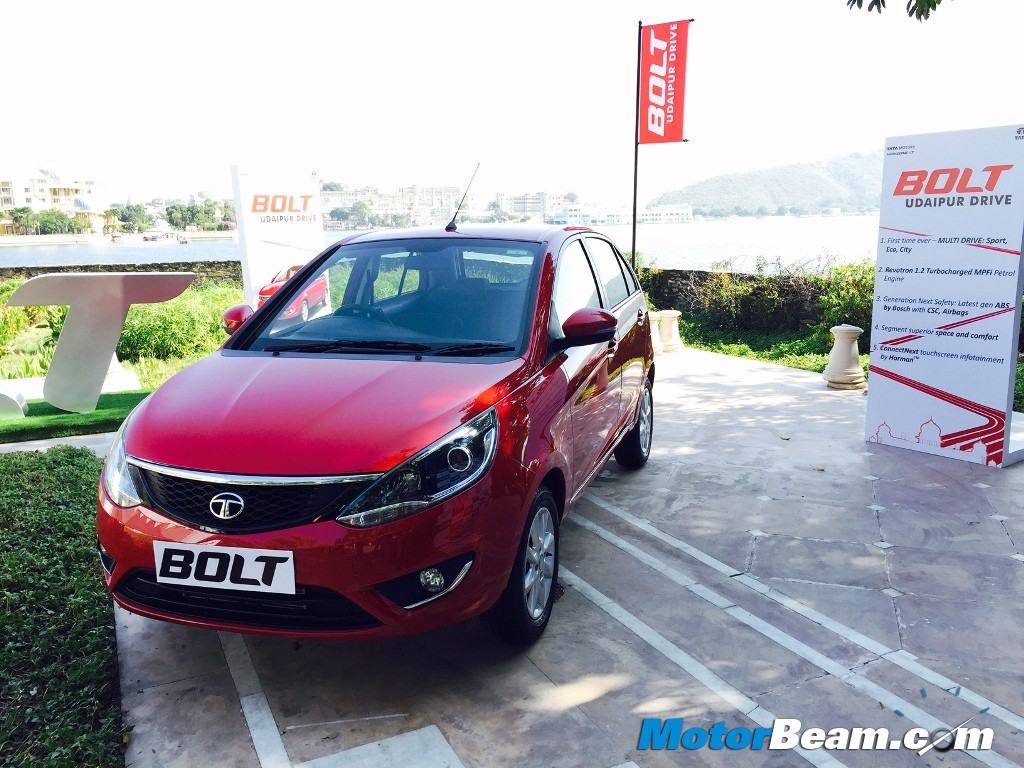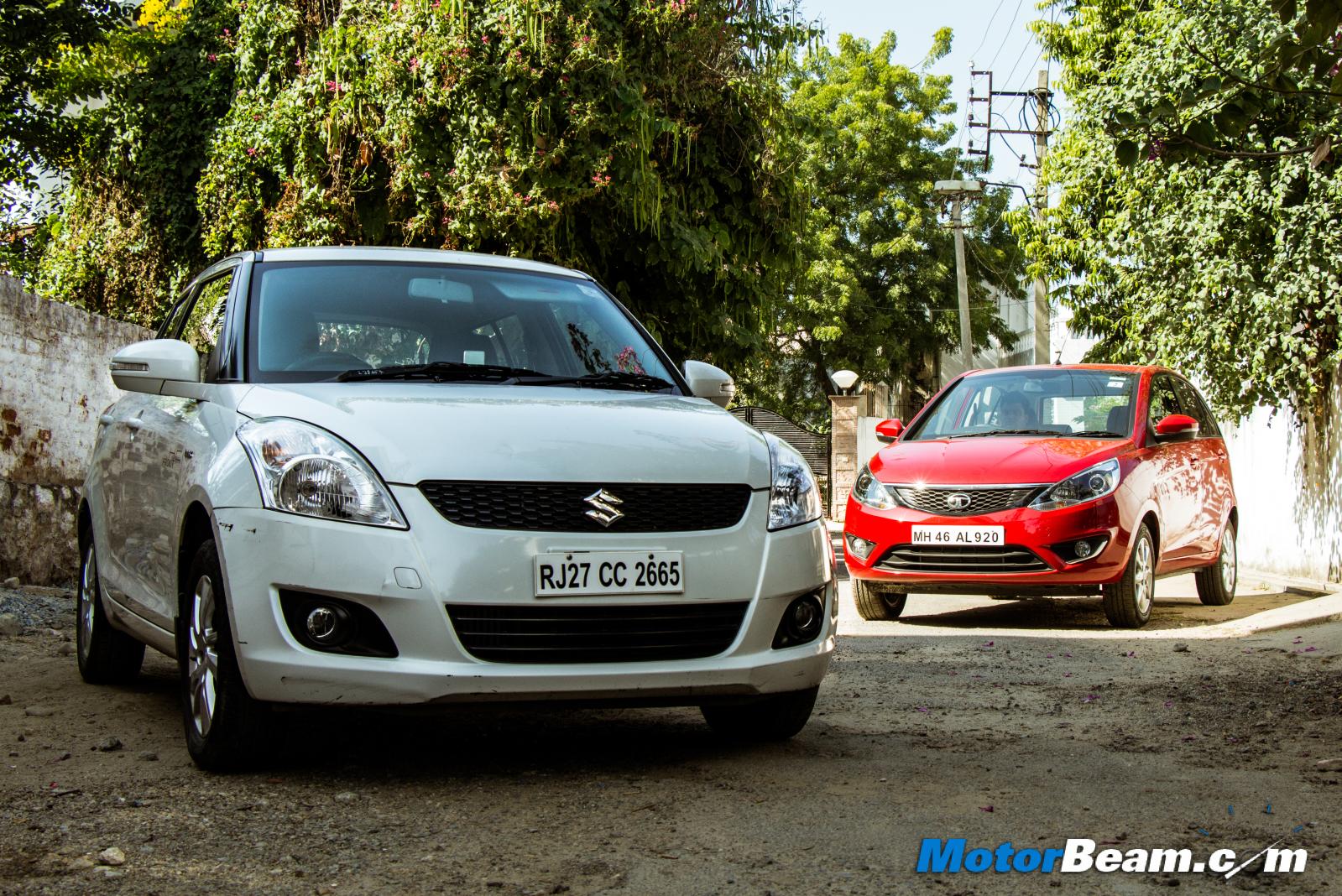
Shootout: Tata Bolt vs Maruti Swift
Price OTR Mumbai: Rs. 5.28 – 8.45 lakhs (Tata Bolt), Rs. 5.29 – 8.40 lakhs (Maruti Swift)
The Bolt offers a more complete package than the Swift in the hatchback segment
Since its launch in 2005, the Maruti Swift has pretty much dominated the hatchback segment and although many cars have come to challenge the supremacy of the Japanese vehicle, few have given it sleepless nights. A car which we think can give the Swift a run for its money is finally here, it’s none other than the Tata Bolt. The homegrown vehicle looks very promising on paper and if its three box sibling is anything to go by, then the Bolt is sure to woo buyers from India’s largest car maker to the desi automaker. Can the hot and fresh Tata Bolt beat the well established Maruti Swift? This head-on shootout between these hatchbacks will give you an answer.
Motor Quest: The second generation Maruti Swift was launched in India in 2005 while the third generation model came in 2011. The Tata Bolt is the third generation of the Indica and made its debut as a concept at the 2014 Auto Expo.
The Swift looks a bit boring now while the Bolt looks fresh with nice design elements
Styling – Neither of these cars come across as brand new designs since both draw heavy inspiration from their predecessors. The third generation Swift sees a design evolution over the second gen model and with the car being on sale for more than three years now, it doesn’t come across as exciting anymore. With a crazy number of Swifts on the road already, the vehicle does look boring and the recent minor update has done little to spruce up the exterior appeal of the vehicle. In comparison, the Bolt does come across as an appealing hatchback although it has the unmistakable silhouette of the Vista.
Both cars have attractive rears and the Tata Bolt has really nice tail lights
Both cars get silver inserts near the foglamps but none come with daytime running lights which is a shame as the silver inserts are unnecessary and the ideal place to have DRLs. Still, it’s the Bolt with its fresher design and better exterior elements which comes across as the better looking car. The Bolt gets projector headlights, blacked C-pillar (for a floating roof appearance) and a rear spoiler. The lights on the Bolt are more appealing while the Swift’s lights lack the appeal you would expect from a car which is positioned as a sporty offering by the company. We particularly love the rear-end design of the Tata Bolt.
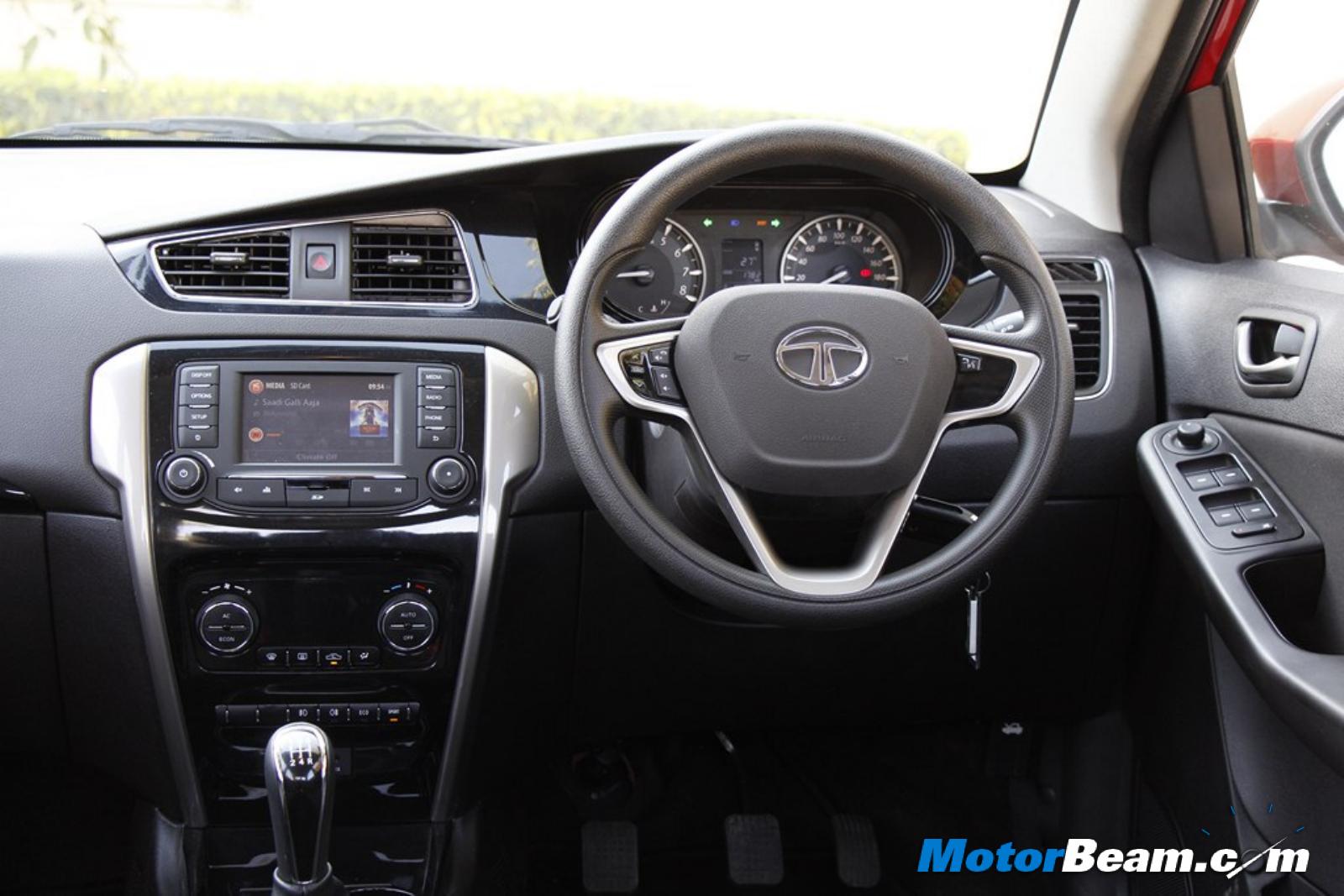
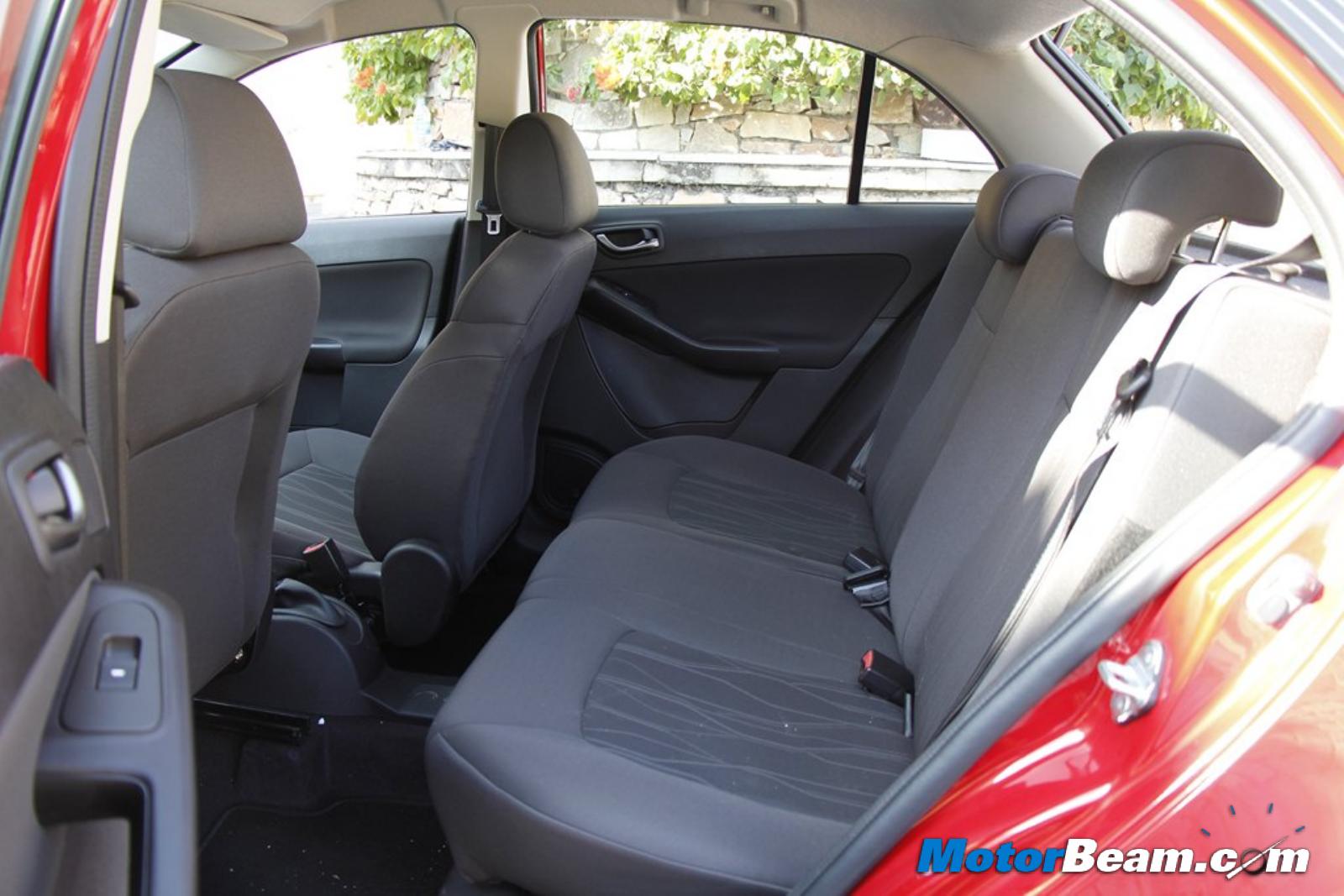
The Tata Bolt has a lot of equipment on board, it offers much more interior room and comfort than the Swift
Interiors – Both cars come with all black interiors and with the recent update to the Swift, the Maruti car now has added equipment, making it a more interesting fight. However, the Bolt is the more loaded car and other than keyless GO, push button start and reverse parking sensors on the Swift, the Bolt has more equipment on offer such as a touch-screen infotainment system from Harman with 8-speakers, video playback, voice commands, SMS readout, navigation, etc. The Bolt also gets follow me home headlamps and projector headlights. Quality inside both cars is good and there is little to differentiate them in that regard but the build of the Tata car is much better and it feels more solidly put-together with doors that shut with a reassuring thud.
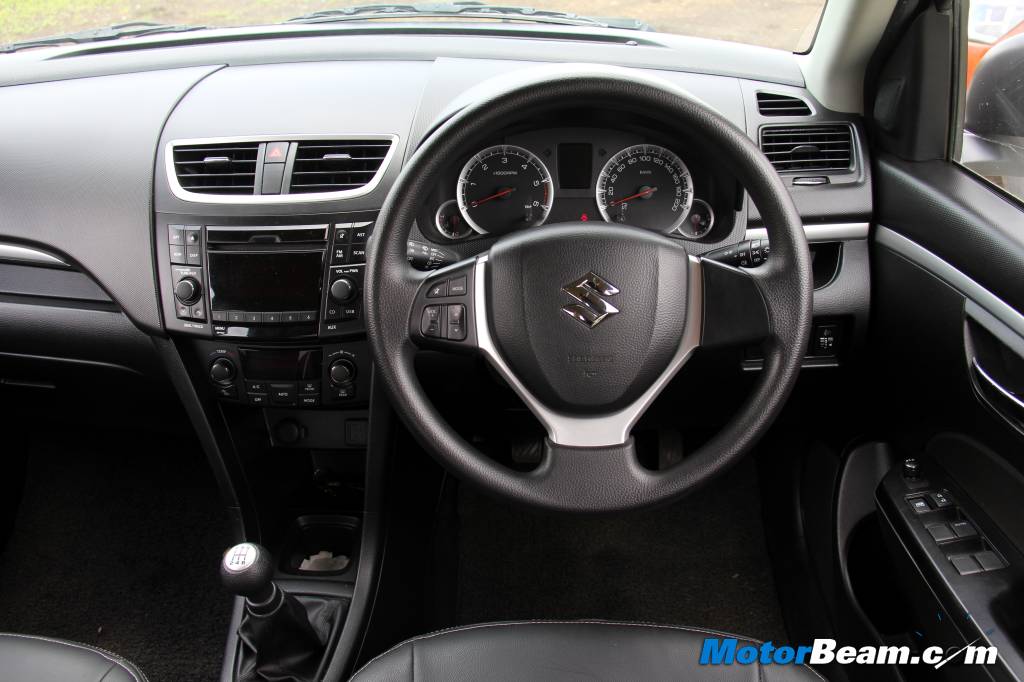
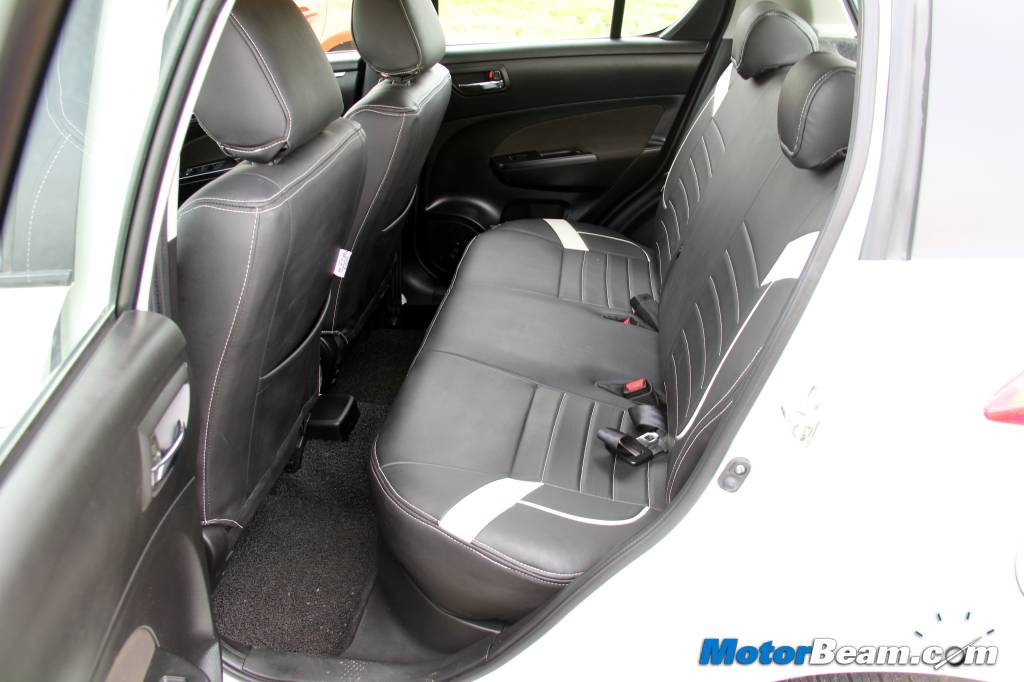
The Swift has got some unique features too (in the facelift) but really lags when it comes to interior space
The Tata Bolt has more interior room than the Maruti Swift, five people can comfortably sit inside this car which is a tough ask in the Swift as it lacks rear seat space. While both cars come with good headroom, the Swift lacks legroom at the rear which is class leading in the case of the Bolt, it also has bigger rear windows giving a better rear seat experience. The Tata vehicle has better seats and a marginally bigger boot too with the Maruti’s loading bay being quite narrow, hampering ease of use. The Swift does come with an electro-magnetic tail gate opener which is a nice touch and the spare wheel is an alloy which is not the case with the Bolt. It also has more storage bins inside the cabin. However, the interiors of the Bolt are more appealing and the dashboard as well as the instrument cluster really come across as modern units with heavy attention to detail.
The Swift and Bolt share their diesel engines, Tata Motors’ tuning is better though
Performance – Both cars come with 1.2-litre petrol and 1.3-litre diesel engines, the oil burner being the same in both vehicles as it’s sourced from Fiat. The diesel engine in the Swift is termed DDiS while Tata calls its Multijet as Quadrajet, both produce 75 PS at 4000 RPM and 190 Nm of torque. However peak torque in the Swift is produced at 2000 RPM while the Bolt is tuned to produce it between 1750 to 3000 RPM. There is no doubt that Tata Motors has tuned the engine better and while the Swift suffers from heavy turbolag, power delivery in the Bolt is linear. The Maruti car being lighter is quicker but the Bolt has the better tuning, offering better city drivability while the Swift shines on the highway with a good top-end which is lacking in the Bolt. Both cars are matched to a smooth shifting 5-speed gearbox, returning similar mileage figures of 16 km/l.
Petrol or diesel, the Swift is the faster car thanks to its lower weight
The Bolt and Swift have very different petrol engines, they differ vastly in driving character
Coming to the petrol engine, the Tata Bolt has many firsts to its credits with the gasoline mill being the first in the segment to have a turbocharger and multi-drive modes. It’s also the most powerful engine in the segment, the 1.2-litre Revotron mill generating 90 PS at 5000 RPM and 140 Nm between 1500-4000 RPM. In comparison, the Swift’s naturally aspirated 1.2-litre K-Series motor belts out 84.3 PS at 6000 RPM and 115 Nm at 4000 RPM. So while the Bolt has a minor horsepower advantage, the torque advantage is massive and that really plays a big role in drivability. Both cars come coupled to a 5-speed gearbox, offering smooth shifts with the mileage being on par too (around 11-13 km/l).
The Tata Bolt has better city drivability with more tractable engines on offer
So which is the better engine of the two? The Swift is faster as it’s lighter but the Bolt is more effortless to drive as there is good low-end punch which plays a crucial part in city driving. The Bolt’s turbo mill has a good low and mid-range while the Swift excels in the mid and top-end. Thus the Swift is the more fun car to drive as the aluminium motor is quicker revving and loves the redlines, rushing there with eagerness and some aural drama to accompany. The Bolt though doesn’t like to be stretched to the redline and isn’t as high or free-revving either, it does have multi-drive modes which help you extract the best from the force-fed unit as per your needs. The Bolt does have better NVH levels and the powerplant is very refined but some vibrations do trickle in through the gearlever which is absent on the Swift.
Steering feedback and handling of the Swift is way superior in front of the Bolt
Driving Dynamics – The Swift is known to be a driver’s car and that is quite evident here as well. With a more driver focussed set-up, the Swift is the more fun car to throw into corners while the Bolt isn’t bad, it’s just not as sharp a handler as the Maruti. The Swift also has the better steering with terrific feedback at speed while the Bolt is good but again not a match for the Japanese vehicle. Where the Bolt does better than the Swift is grip levels, it comes with good tyres while the Swift’s rubber is a cost cutting measure that spoils what is otherwise a fantastic handling vehicle. The smaller turning radius of the Swift makes it easier to take u-turns in but the difference isn’t vast.
The Bolt rides better than the Swift, it also is more stabile with better brakes
Where the Maruti Swift can’t match the Tata Bolt is ride quality, the Indian vehicle absorbing everything in its stride with utmost confidence. The Swift’s ride quality is far from impressive and if you want comfort, the Bolt is acres ahead of the Suzuki. Weighing more than the Swift, the Bolt also has better driving feel as the Swift tends to show its lightness when driven hard. The Bolt is more stable at speed and has the better brakes too. Handling aside, the Bolt fares better here but if you love driving, the Swift is the car to be in.
Maruti is far ahead in after sales but doesn’t perform well when it comes to safety
Safety and After Sales Service – The Maruti Swift was recently tested by Global NCAP and it performed very poorly. The Bolt is yet to be tested but given the stronger build of Tata cars, it should fare better than the Maruti. Both cars come with dual front airbags and ABS on the top trims while the Bolt also gets Corner Stability Control. The service network of Maruti Suzuki is bigger than that of Tata Motors and service quality of the Japanese firm is better as well. Tata Motors has put in place a series of changes to its dealerships which should drastically improve the customer experience.
The Tata Bolt is a better package than the Maruti Swift, offering more value
Verdict – The Tata Bolt comes across as a better car than the Maruti Swift. The Suzuki vehicle does excel in certain things like handling, proven reliability, resale and service experience. However, the Bolt offers more bang for the buck. Not only is the Tata vehicle generously loaded, it’s more appealing inside-out. With Tata Motors offering much more interior room, better ride quality and more practical engines for daily use, it’s the Vista replacement which offers more car per car here, making the Tata Bolt the winner of this shootout.
The Tata Bolt has better tuned engines for city driving but the Swift is the more fun car here. However, the Bolt offers more space, better interiors and an amazing ride quality compared to the Swift, helping it beat the Japanese in this shootout.
Further Reading –
Tata Bolt Review
Maruti Swift vs Hyundai Grand i10
Tata Bolt vs Maruti Swift vs Hyundai Grand i10
Picture Editing – Sri Manikanta Achanta


